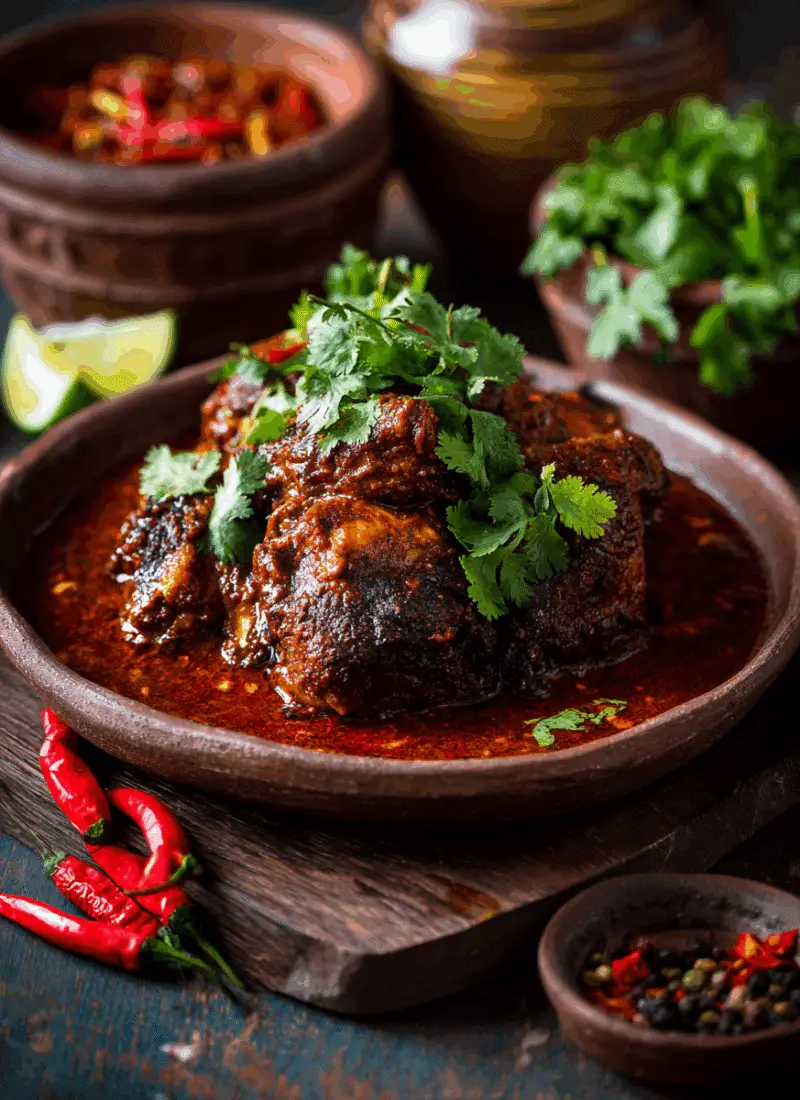Mole Poblano Chicken is one of Mexico’s most iconic and beloved dishes, often enjoyed during special celebrations like Mexican Independence Day. This complex sauce combines earthy dried chiles, aromatic spices, nuts, seeds, and a hint of chocolate for a smoky, rich, and slightly sweet flavor that pairs beautifully with tender chicken. Its origins trace back to Puebla, where it was first prepared in convent kitchens centuries ago.
FULL RECIPE
Ingredients
- 4 bone-in, skin-on chicken thighs
- 4 bone-in chicken drumsticks
- 2 cups chicken broth (plus extra if needed)
- 2 tablespoons vegetable oil
- 3 dried ancho chiles, stemmed, seeded, and torn into pieces
- 3 dried pasilla chiles, stemmed, seeded, and torn into pieces
- 2 dried mulato chiles, stemmed, seeded, and torn into pieces
- 1 corn tortilla, torn into pieces
- 1 small slice of stale bread (about 1 ounce)
- 1 medium ripe plantain, sliced
- 2 tablespoons sesame seeds (plus extra for garnish)
- 2 tablespoons almonds
- 2 tablespoons peanuts
- 1 cinnamon stick
- 4 whole cloves
- 4 black peppercorns
- 1 teaspoon coriander seeds
- 1 teaspoon anise seeds
- 3 garlic cloves, peeled
- 1 medium white onion, chopped
- 2 medium tomatoes, chopped
- 1/4 cup raisins
- 1 ounce Mexican chocolate (or bittersweet chocolate)
- 1 teaspoon sugar (optional, adjust to taste)
- Salt, to taste
Directions
- Cook the chicken: In a large pot, place chicken thighs and drumsticks with 2 cups of chicken broth. Bring to a boil, reduce heat, and simmer until cooked through (about 25 minutes). Remove chicken and set aside. Reserve the broth.
- Prepare the chiles: In a large skillet, heat 1 tablespoon of oil over medium heat. Toast ancho, pasilla, and mulato chiles for about 1–2 minutes, pressing gently until fragrant (do not burn). Transfer to a bowl and cover with hot water to soften for 15 minutes.
- Fry the thickening agents: In the same skillet, add the torn tortilla and bread slice. Fry until golden and crisp. Remove and set aside.
- Fry the plantain: Add a little more oil if needed and fry plantain slices until golden. Remove and set aside.
- Toast the nuts and spices: Add sesame seeds, almonds, peanuts, cinnamon stick, cloves, peppercorns, coriander, and anise seeds to the skillet. Toast for 2–3 minutes until fragrant. Remove and set aside.
- Cook the aromatics: Add garlic and onion to the skillet, cooking until softened. Add chopped tomatoes and raisins; cook until tomatoes break down.
- Blend the mole: Drain the soaked chiles and place them in a blender. Add the fried tortilla, bread, plantain, toasted nuts and spices, garlic, onion, tomatoes, raisins, and about 2 cups of the reserved chicken broth. Blend until smooth, adding more broth if needed for a thick but pourable consistency.
- Simmer the sauce: Pour the blended mixture back into the pot. Stir in the Mexican chocolate and cook over low heat for 30–40 minutes, stirring often to prevent sticking. Season with salt and sugar (if using).
- Add the chicken: Place cooked chicken into the mole sauce, turning to coat. Simmer for another 10–15 minutes so the flavors meld.
- Serve: Garnish with extra sesame seeds and serve hot with Mexican rice and warm tortillas.
Nutrition Facts
- Calories: 480
- Protein: 27g
- Total Fat: 29g
- Saturated Fat: 7g
- Cholesterol: 115mg
- Carbohydrates: 29g
- Fiber: 7g
- Sugars: 10g
- Sodium: 520mg
- Vitamin A: 25% DV
- Vitamin C: 20% DV
- Calcium: 10% DV
- Iron: 20% DV
Historical Significance of Mole Poblano
Mole Poblano holds a special place in Mexican culinary history as one of the country’s most celebrated dishes. Its origins trace back to Puebla in the colonial era, where it was believed to have been created in convent kitchens by nuns who combined indigenous ingredients with Spanish influences. Over the centuries, the sauce became a symbol of cultural fusion, blending Old World spices with native chiles and cacao. Today, it is a staple during significant festivities, particularly on Mexican Independence Day, serving as a dish that connects modern celebrations with historical tradition.
Flavor Profile and Complexity
One of the defining characteristics of Mole Poblano is its deep, layered flavor. It balances smokiness from dried chiles, nuttiness from seeds and nuts, sweetness from plantains and raisins, and bitterness from chocolate, all harmonized with aromatic spices. This combination creates a sauce that evolves with every bite, offering hints of warmth, richness, and mild sweetness. The unique flavor complexity is why it is considered one of the most sophisticated sauces in Mexican cuisine, often taking hours to prepare to achieve the perfect depth.
Nutritional Benefits
While Mole Poblano is rich and indulgent, it also offers surprising nutritional value. The inclusion of dried chiles provides vitamin C, capsaicin for metabolism support, and antioxidants that help fight inflammation. Nuts and seeds contribute healthy fats, plant-based protein, and essential minerals such as magnesium and zinc. Plantains add dietary fiber and potassium, while chocolate provides flavonoids known for cardiovascular health benefits. By using lean chicken and moderate portions, Mole Poblano can be a nourishing part of a balanced meal.
Regional Variations
Although Puebla is the birthplace of Mole Poblano, regional adaptations have emerged across Mexico. In Oaxaca, for example, the sauce may feature more types of chiles and a greater emphasis on earthy flavors. Some regions incorporate additional sweet notes with dried fruits like prunes or apricots, while others lean toward spicier profiles by increasing the chile-to-chocolate ratio. Outside of Mexico, home cooks and chefs sometimes adapt the recipe by using locally available chiles and substituting plantains with bananas or sweet potatoes, resulting in slightly different but equally flavorful interpretations.
Serving Suggestions
Mole Poblano is traditionally served over chicken, but its versatility allows it to complement other proteins such as turkey, pork, or even tofu for a vegetarian twist. It is commonly accompanied by fluffy Mexican rice and warm corn tortillas, which help soak up the flavorful sauce. For a more festive presentation, it can be garnished with toasted sesame seeds and served with pickled vegetables on the side. The sauce also pairs well with tamales or enchiladas, transforming them into special-occasion dishes.
Perfect Pairings
Pairing Mole Poblano with the right sides and drinks enhances the overall dining experience. Traditional accompaniments include refried beans, nopales salad, and freshly made salsa for added brightness. In terms of beverages, a light Mexican beer, hibiscus tea (agua de jamaica), or even a smooth red wine such as Merlot can balance the sauce’s richness. Desserts like flan or tres leches cake make for a sweet ending that complements the depth of the mole without overpowering it.
Storage and Reheating Tips
Mole Poblano’s flavors often deepen after a day, making it an excellent make-ahead dish. The sauce can be stored in the refrigerator for up to five days in an airtight container. For longer storage, freezing is ideal—simply portion the sauce into freezer-safe bags or containers, where it can last for up to three months. When reheating, use low heat on the stovetop, adding a splash of broth to loosen the consistency if it has thickened during storage. Avoid microwaving, as it can cause uneven heating and alter the sauce’s texture.
Common Mistakes to Avoid
A frequent pitfall when making Mole Poblano is burning the chiles during toasting, which can make the sauce bitter. It’s also important not to skip the soaking process for dried chiles, as it softens them and helps release their flavors during blending. Using too much chocolate can overwhelm the sauce, making it overly sweet, while under-seasoning can leave it flat and unbalanced. Finally, rushing the simmering process can prevent the ingredients from fully melding, resulting in a less harmonious flavor profile.
Cultural Role in Celebrations
Beyond its culinary appeal, Mole Poblano holds cultural importance during Mexican Independence Day and other national holidays. Serving the dish during these events is a nod to Mexican history, as it symbolizes the blending of indigenous and Spanish culinary traditions. Families often gather in kitchens to prepare mole together, making it a social and generational tradition. The act of sharing Mole Poblano represents hospitality, unity, and pride in Mexican heritage, turning a meal into a celebration of culture and identity.
Conclusion
Mole Poblano Chicken is more than just a meal it’s a culinary masterpiece that represents centuries of cultural blending, family traditions, and Mexican pride. Its balance of smoky, sweet, spicy, and earthy flavors makes it one of the most complex sauces in the world. While its preparation can be time-intensive, the result is a richly rewarding dish perfect for festive gatherings or special family meals.








